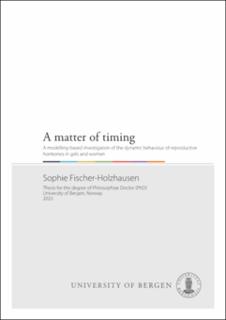A matter of timing : A modelling-based investigation of the dynamic behaviour of reproductive hormones in girls and women
Doctoral thesis

Åpne
Permanent lenke
https://hdl.handle.net/11250/3065157Utgivelsesdato
2023-05-05Metadata
Vis full innførselSamlinger
Sammendrag
Hypothalamus-hypofyse-gonade aksen er en del av det kvinnelige endokrine systemet, og regulerer evnen til reproduksjon. Hormoner produsert og utskilt fra tre kjertler (hypotalamus, hypofysen, eggstokkene) påvirker hverandre via tilbakemeldingsinteraksjoner, som er nødvendige for å etablere en regelmessig menstruasjonssyklus hos kvinner. Matematiske modeller som forutsier utviklingen av slike hormonkonsentrasjoner og modning av eggstokkfollikler er nyttige verktøy for å forstå menstruasjonssyklusens dynamiske oppførsel. Slike modeller kan for eksempel hjelpe oss med å undersøke patologiske tilstander som endometriose og polycystisk ovariesyndrom. Videre kan de brukes til systematiske undersøkelser av effekten av medikamenter på det kvinnelige endokrine systemet. Derfor kan vi potensielt bruke slike menstruasjonsyklusmodeller som kliniske beslutningsstøttessystemer.
Vi trenger modeller som forutsier hormonkonsentrasjoner sammen med modningen av eggstokkfollikler hos enkeltindivider gjennom påfølgende sykluser. Dette for å kunne simulere hormonelle behandlinger som stimulerer vekst av eggstokkfolliklene (eggstokkstimuleringsprotokoller). Her legger jeg fram et forslag til en matematisk menstruasjonsyklusmodell og viser modellens evne til å forutsi resultatet av eggstokkstimuleringsprotokoller.
For å kalibrere denne typen modell trenges individuelle tidsseriedata. Innsamling av slike data er tidskrevende, og forutsetter høy grad av engasjement fra deltakerne i studien. Det er derfor viktig å finne brukbare datatyper som er mindre tid- og ressurskrevende å samle inn, og som likevel kan brukes til modellkalibrering. En type data som er enklere å samle inn er tversnittdata. I denne avhandlingen har jeg utviklet en prosedyre for å bruke tversnittpopulasjonsdata i modellens kalibreringsprosess, og viser hvordan en modell kalibrert med tversnittdata kan brukes til å forutsi individuelle resultater ved oppdatering av en del av modellens parametere.
I tillegg til det vitenskapelige bidraget, håper jeg at avhandlingen min skaper oppmerksomhet rundt viktigheten av forskning på kvinners reproduktive helse, og at avhandlingen underbygger verdien av matematiske modeller i forskning på kvinnehelse. The hypothalamic-pituitary-gonadal axis (HPG axis), a part of the human endocrine system, regulates the female reproductive function. Feedback interactions between hormones secreted from the glands forming the HPG axis are essential for establishing a regular menstrual cycle. Mathematical models predicting the time evolution of hormone concentrations and the maturation of ovarian follicles are useful tools for understanding the dynamic behaviour of the menstrual cycle. Such models can, for example, help us to investigate pathological conditions, such as endometriosis or Polycystic Ovary Syndrome. Furthermore, they can be used to systematically study the effects of drugs on the endocrine system. In doing so, menstrual cycle models could potentially be integrated into clinical routines as clinical decision support systems.
For the simulation-based investigation of hormonal treatments aiming to stimulate the growth of ovarian follicles (Controlled Ovarian Stimulation (COS)), we need models that predict hormone concentrations and the maturation of ovarian follicles in biological units throughout consecutive cycles. Here, I propose such a mechanistic menstrual cycle model. I also demonstrate its capability to predict the outcome of COS.
Individual time series data is usually used to calibrate mechanistic models having clinical implications. Collecting these data, however, is time-consuming and requires a high commitment from study participants. Therefore, integrating different data sets into the model calibration process is of interest. One type of data that is often more feasible to collect than individual time series is cross-sectional data. As part of my thesis, I developed a workflow based on Bayesian updating to integrate cross-sectional data into the model calibration process. I demonstrate the workflow using a mechanistic model describing the time evolution of reproductive hormones during puberty in girls. Exemplary, I show that a model calibrated with cross-sectional data can be used to predict individual dynamics after updating a subset of model parameters.
In addition to the scientific contributions of this thesis, I hope that it creates attention for the importance of research in the area of women's reproductive health and underpins the value of mathematical modelling for this field.
Består av
Paper 1: S. Fischer-Holzhausen and S. Röblitz. A workflow for incorporating cross-sectional data into the calibration of dynamic models. bioRxiv, 523407, 2023. The article is available in the thesis file. The article is also available at: https://doi.org/10.1101/2023.01.17.523407Paper 2: S. Fischer-Holzhausen and S. Röblitz. Hormonal regulation of ovarian follicle growth in humans: Model-based exploration of cycle variability and parameter sensitivities. Journal of Theoretical Biology, 547:111150, 2022. The article is available at: https://hdl.handle.net/11250/3002068
Paper 3: S. Fischer-Holzhausen and S. Röblitz. Mathematical modelling of follicular growth and ovarian stimulation. Current Opinion in Endocrine and Metabolic Research, 26: 100385, 2022. The article is available at: https://hdl.handle.net/11250/3023570
Paper 4: K. Yamamoto, S. Fischer-Holzhausen, M. P. Fjeldstad, and M. M. Maleckar. Ordinary Differential Equation-based Modeling of Cells in Human Cartilage. Computational Physiology, pages 25–39, 2022. The article is available at: https://doi.org/10.1007/978-3-031-05164-7_3
Paper 5: S. Fischer-Holzhausen, K. Yamamoto, M. P. Fjeldstad, and M. M. Maleckar. Probing the Putative Role of KATP Channels and Biological Variability in a Mathematical Model of Chondrocyte Electrophysiology. Bioelectricity, 3(4):272–281, 2021. The article is available at: https://doi.org/10.1089/bioe.2021.0034
Paper 6: S. Fischer, R. Ehrig, S. Schäfer, E. Tronci, T. Mancini, M. Egli, F. Ille, T. H. Krüger, B. Leeners, and S. Röblitz. Mathematical Modeling and Simulation Provides Evidence for New Strategies of Ovarian Stimulation. Frontiers in Endocrinology, 12:613048, 2021. The article is available at: https://hdl.handle.net/11250/2766376